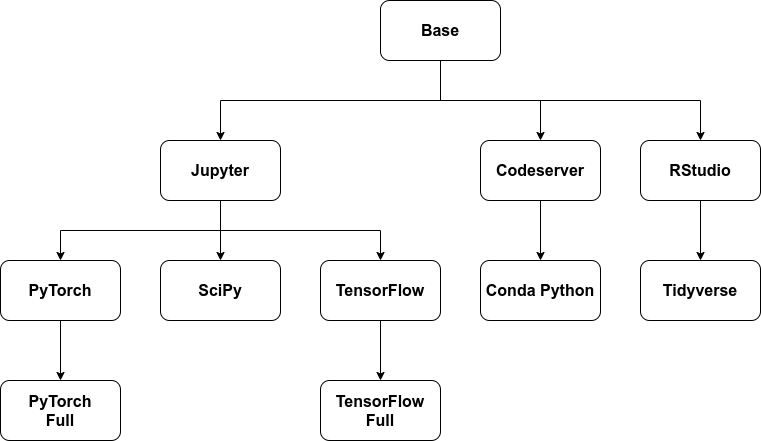🛑️️ Images are provided as examples and are supported on a best-effort basis. Contributions are greatly appreciated.
These images provide a common starting point for Kubeflow Notebook containers. See the custom images guide to learn how to extend them with your own packages.
| Dockerfile | Registry | Notes |
|---|---|---|
| ./base | {REGISTRY}/base:{TAG} |
common base image |
| ./codeserver | {REGISTRY}/codeserver:{TAG} |
base code-server (Visual Studio Code) image |
| ./jupyter | {REGISTRY}/jupyter:{TAG} |
base JupyterLab image |
| ./rstudio | {REGISTRY}/rstudio:{TAG} |
base RStudio image |
These images extend the base images with common packages used in the real world.
This chart shows how the images are related to each other.
- make your custom images by extending one of the base images
- images run as the
jovyanuser - images use the s6-overlay init system to manage processes
Packages installed by users after spawning a Kubeflow Notebook will only last the lifetime of the pod (unless installed into a PVC-backed directory). To ensure packages are preserved throughout Pod restarts users will need to either:
- Build custom images that include them, or
- Ensure they are installed in a PVC-backed directory
⚠️ a common cause of errors is users runningpip install --user ..., causing the home-directory (which is backed by a PVC) to contain a different or incompatible version of a package contained in/opt/conda/...
Extend one of the base images and install any pip or conda packages your Kubeflow Notebook users are likely to need.
As a guide, look at jupyter-pytorch-full.cpu for a pip install ... example, and the rstudio-tidyverse for conda install ....
⚠️ ensure you swap torootin the Dockerfile before runningapt-get, and swap back tojovyanafter.
Extend one of the base images and install any apt-get packages your Kubeflow Notebook users are likely to need.
Some use-cases might require custom scripts to run during the startup of the Notebook Server container, or advanced users might want to add additional services that run inside the container (for example, an Apache or NGINX web server). To make this easy, we use the s6-overlay.
The s6-overlay differs from other init systems like tini.
While tini was created to handle a single process running in a container as PID 1, the s6-overlay is built to manage multiple processes and allows the creator of the image to determine which process failures should silently restart, and which should cause the container to exit.
Scripts that need to run during the startup of the container can be placed in /etc/cont-init.d/, and are executed in ascending alphanumeric order.
An example of a startup script can be found in ./rstudio/s6/cont-init.d/02-rstudio-env-fix.
This script uses the with-contenv helper so that environment variables (passed to container) are available in the script.
The purpose of this script is to snapshot any KUBERNETES_* environment variables into the Renviron.site at pod startup, as without these variables kubectl does not work.
Extra services to be monitored by s6-overlay should be placed in their own folder under /etc/services.d/ containing a script called run and optionally a finishing script finish.
For more information about the run and finish scripts, please see the s6-overlay documentation.
An example of a service can be found in the run script of jupyter/s6/services.d/jupyterlab which is used to start JupyterLab itself.
⚠️ our example images runs6-overlayas$NB_USER(notroot), meaning any files or scripts related tos6-overlaymust be owned by the$NB_USERuser to successfully run
There may be cases when you need to run a service as root, to do this, you can change the Dockerfile to have USER root at the end, and then use s6-setuidgid to run the user-facing services as $NB_USER.
Kernel stuck in connecting state:
This is a problem that occurs from time to time and is not a Kubeflow problem, but rather a browser. It can be identified by looking in the browser error console, which will show errors regarding the websocket not connecting. To solve the problem, please restart your browser or try using a different browser.
